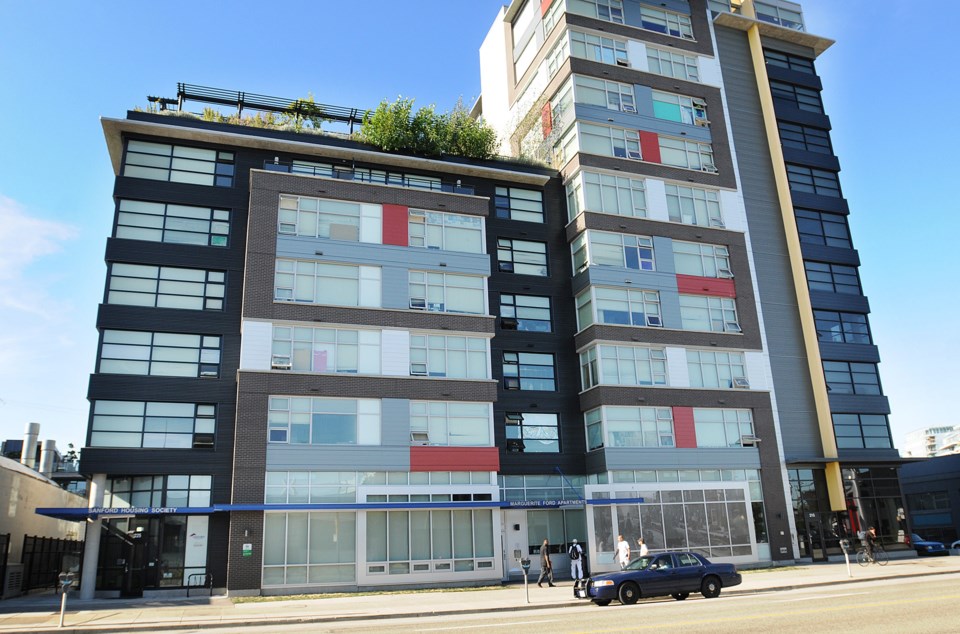As I’ve come to learn on the job, there’s always more to the story.
So I’ve got some more information for you regarding the lengthy piece I wrote Wednesday about the problems facing the Marguerite Ford Apartments on West Second Avenue.
In case you missed it, it was a look at why the 147-unit social housing complex generated 729 police calls in its first 16 months.
At the root of the story was how moving in a high percentage of homeless people with mental health and addictions issues, or both, into a building without proper support services led to drug activity, fights and general public disorder.
Housing Minister Rich Coleman is not pleased.
The Marguerite Ford building is one of 14 projects open or in development that the provincial government agreed to build across the city. So far, 10 are open. The city put up the land for all 14 sites, with the Streetohome Foundation contributing $2.9 million to the Marguerite Ford project and several million dollars to some of the other buildings.
The reason Coleman isn’t pleased is because he said the provincial government reluctantly agreed to the city’s wish to revise a 2007 agreement between the two parties to increase the number of homeless people in Marguerite Ford and the other buildings.
The new information I obtained?
A copy of the revised agreement, signed by city manager Penny Ballem and B.C. Housing CEO Shayne Ramsay, dated Aug. 2, 2012, that allowed for more homeless people to move into the buildings.
Here’s two key paragraphs of the agreement:
• “Both B.C. Housing and the City will work together with Vancouver Coastal Health Authority (where appropriate) and the non-profit operators to expedite tenanting of the new supportive housing buildings within four to six weeks of an occupancy permit being issued.”
• “B.C. Housing and the City agree that monitoring the outcomes of this major public policy initiative is essential and will work with Vancouver Coastal Health Authority (where appropriate) and the academic community to assist with appropriate metrics and research to answer key questions related to outcomes.”
As Coleman and others told me, there are indeed many key questions.
Some of mine have been answered, but not all.
In a series of email exchanges with the city’s communications department, I learned – and as I reported -- the Marguerite Ford building was the first of the bunch to adopt the so-called 50-30-20 formula.
That means 50 per cent of tenants must be from the street or shelter, 30 per cent from single-room occupancy hotels and 20 per cent at risk of homelessness, including people discharged from hospitals and jails.
The city said another one of the 14 buildings opened in May at 1134 Burrard “was tenanted with this ratio and it is working well (and similar size to Marguerite Ford which is a good indication that the City and partners have taken the lessons learned from Marguerite Ford).”
Added the communications staffer, who abides by the city’s ridiculous media policy where staffers request their name not be published and the information supplied only on, as they say, background: “Right now all the rest are working with their tenanting list and are working hard to achieve the 50-30-20 rule.”
The four remaining buildings to be built are located at 1050 Expo Blvd (89 units), 111 Princess (139 units), 2465 Fraser (99 units) and 220 Princess (147 units) for a total of 473 units.
Hmmm…the stats the city sent me said the four buildings totalled 617 units.
Turns out the city overshot the number of units for 2465 Fraser St. by 144; probably just a typo, or miscalculation, but that kind of mistake doesn’t help when explaining a complicated story with a lot of numbers in it.
It also doesn’t help when Mayor Gregor Robertson told me a couple of weeks ago that the city was now dealing mainly with noise complaints at Marguerite Ford. When I enquired with the city’s communications department about the noise, I was informed “to date, the city has not received any noise complaints for this building.”
Huh?
Anyway, in my interview last week with city manager Penny Ballem, she told me the city is now using a new method of assessing tenants before they are selected to move into a social housing building.
It’s used in Portland, Ore. and it’s called the vulnerability assessment tool and apparently B.C. Housing paid for the training of several staff from non-profits and the city’s homeless workers to learn how it works.
“It was applied retroactively at the Marguerite Ford building and demonstrated many tenants did not have the mental health support services they needed,” said the communications staffer. “[Vancouver Coastal Health] has increased their support services to those tenants in need.”
One other thing on this: The VPD stats that show police answered 729 police calls at Marguerite Ford between the month it opened in May 2013 to August of this year are only related to the address of the building.
As a police officer told me, the statistic does not capture the number of calls that occurred in the same block or neighbourhood that may or may not be related to problems at Marguerite Ford.
At the writing of this post, Global News was outside the building and attempting to follow up on my story. Anchor Chris Gailus tweeted: “Anyone living at #Olympic Village brave enough to talk on camera re: Marguerite Ford impact? All pretty shy today!”
Not surprised.
twitter.com/Howellings



